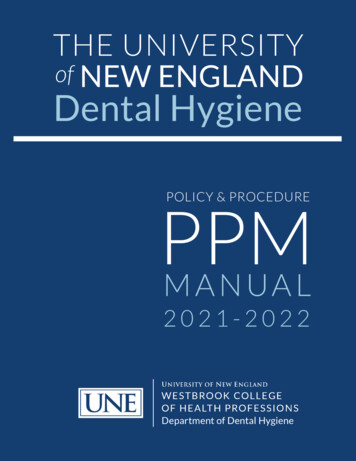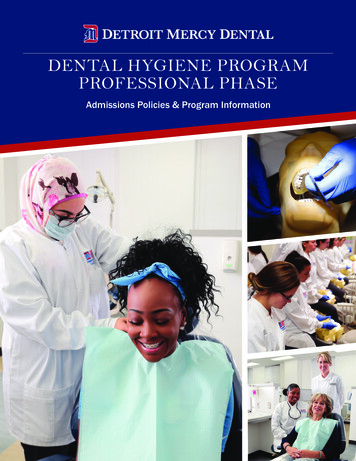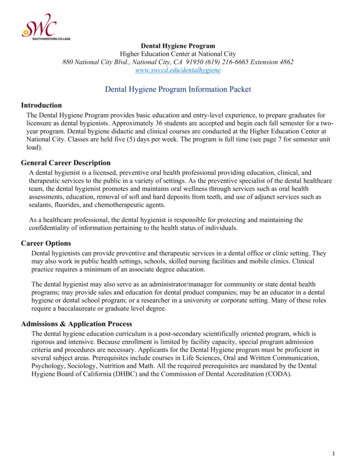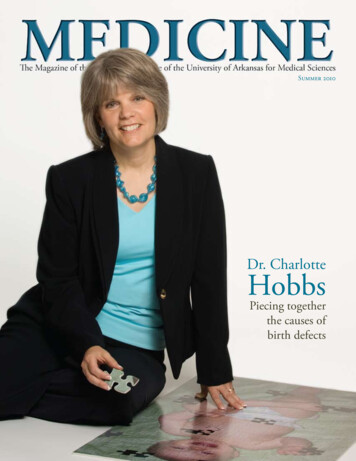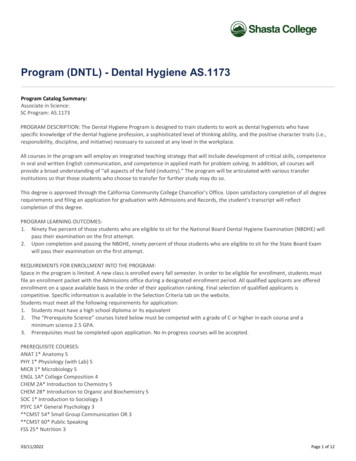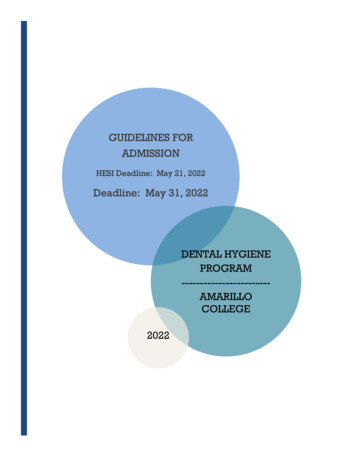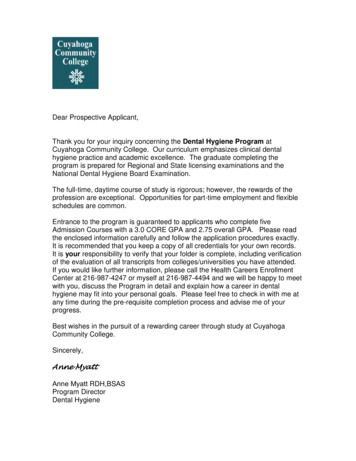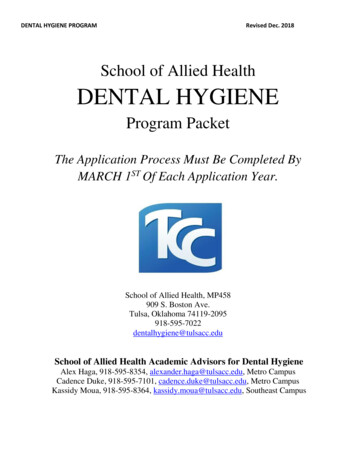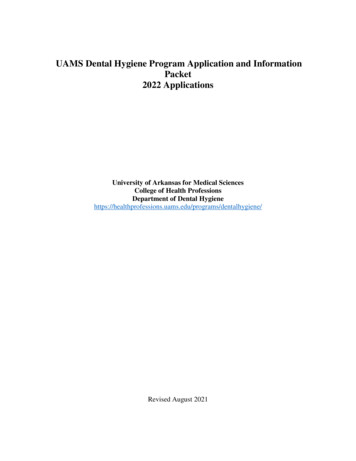
Transcription
UAMS Dental Hygiene Program Application and InformationPacket2022 ApplicationsUniversity of Arkansas for Medical SciencesCollege of Health ProfessionsDepartment of Dental /dentalhygiene/Revised August 2021
THE DENTAL HYGIENE PROGRAMThe dental hygiene program is in the Department of Dental Hygiene, which is part of the Collegeof Health Professions (CHP) at the University of Arkansas for Medical Sciences.CURRICULUM & DEGREE OPTIONThe UAMS Department of Dental Hygiene offers a Bachelor of Science degree. Graduates arequalified to apply for state, regional, and national examinations required for licensure.PREREQUISITE COURSESWhen selecting courses to fulfill the prerequisite course requirements please be advised that thefinal determination of the suitability of prerequisite course work lies with the dental hygieneprogram. Prerequisite course selection guides for many Arkansas institutions can be found on thewebpage www.healthprofessions.uams.edu/dentalhygiene . If there is any question about acourse being accepted as a program prerequisite, please call the CHP Admissions Officer at(501) 686-5730 for verification.Prerequisites and Degree RequirementsThe following 51 credits are required for admission. All listed courses are required from aregionally accredited post-secondary academic institution and must fulfill all Collegerequirements regarding acceptance of transfer credit. If the applicant is in doubt of thesuitability of the following prerequisite courses, please contact the CHP Office ofAdmissions.Area/Typical Course TitleEnglish/CommunicationEnglish CompositionTwo-semester sequence of English CompositionMinimum Credits6Speech CommunicationFundamentals of Speech or Speech Communication*3MathematicsCollege Algebra (or higher level Mathematics)3SciencesChemistryPrinciples of chemistry course with laboratory4Anatomy & PhysiologyAnatomy & Physiology I & II (no labs required)6BiologyPrinciples of biology course with laboratory(A zoology course is also acceptable.)4
MicrobiologyMicrobiology with laboratoryFine Arts/HumanitiesFine ArtsMusic, Art, TheaterHumanitiesPhilosophy, Political Science, Literature, or Humanities433Social SciencesHistoryHistory of the United States or National Government3PsychologyGeneral Psychology3SociologyIntroduction to Sociology3Lower Level Electives6TOTAL 51Applicants may select the lower level electives.The program does not accept CLEP credit for science courses.A course grade of “C” or higher is required to complete all prerequisite course worklisted above.PROGRAM CURRICULUMThe following 69 credits are required:Course #TitleYear 1FallDHYG 2211 Introduction to Dental Hygiene TheoryDHYG 2215 Oral AnatomyDHYG 2217 Dental Radiography IDHYG 3315 Head and Neck AnatomyDHYG 2513 Dental Hygiene Pre-clinicDHYG 2517 Periodontal InstrumentationSpringDHYG 2116Oral Embryology and HistologyCredits322441161
DHYG 2119DHYG 2223DHYG 2231DHYG 2331DHYG 3242DHYG 3434SummerDHYG 3245DHYG 3246Dental Hygiene Seminar IDental Radiography IIDental Hygiene Theory IDental Hygiene Clinic IManagement of Patients with Special NeedsPathology12323416Dental Hygiene Clinic—SummerLocal Anesthesia224Year 2FallDHYG 2327DHYG 3231DHYG 3331DHYG 3332DHYG 3335DHYG 3344Dental MaterialsDental Hygiene Theory IIDental Hygiene Clinic IIPharmacologyPeriodontologyCommunity Dentistry I32333317SpringDHYG 3119DHYG 3241DHYG 3242DHYG 4411DHYG 3244DHYG 3333DHYG 3341Dental Hygiene Seminar IIDental Hygiene Theory IIIManagement of Patients with Special NeedsNBDHE Review CourseCommunity Dentistry IINutritionDental Hygiene Clinic III12332331669TOTALPERFORMANCE REQUIREMENTSIn order to accomplish the objectives of the dental hygiene program, students must be able tomeet the following performance requirements: Professional attitude during all phases of the application process. If at any time during theprocess, it is determined that your attitude or actions are unprofessional, your applicationmay not be considered for acceptance.Visual acuity with corrective lenses to identify oral tissue changes and evaluate treatmenteffectiveness.Hearing ability with auditory aids to understand the normal speaking voice withoutviewing the speaker’s face and take/hear blood pressure with a stethoscope.
Physical ability to sit for prolonged periods of time, perform repetitive wrist motion forinstrumentation, and move from room to room or maneuver in limited spaces.Written and verbal communication skills to succinctly describe patient conditions,document findings in a patient record and implement oral health teachings.Manual dexterity to use a variety of instruments in the small, confined space of the oralcavity.Function safely under stressful conditions with the ability to adapt to an ever-changingenvironment inherent in clinic situations involving patient care.Computer skills to use a variety of software programs and the Internet for research andcourse projects; power point utilized for presentations.Time management skills in order to effectively and efficiently sequence treatment needs.The most qualified applicants will be invited for an interview. Interviews are held in March andApril. A class of approximately 36 students is typically selected. Applicants selected forenrollment will receive notification by the end of June. Selected applicants are required tocomplete a criminal background check and drug test. Licensure in Arkansas also requires a stateand federal criminal background check.TYPICAL PROGRAM SCHEDULEThe UAMS dental hygiene program is a full-time, weekday commitment. Classes, laboratorysessions, and clinical sessions are scheduled Monday through Friday during the hours of 8am to5pm. The Department does not offer evening classes. The program ascribes to a very strictattendance policy, and attendance is taken at every course/clinic session.PROGRESSION & GRADUATIONA grade of “C” or better in all pre-clinical and clinical courses is required for continuation in theprogram. Students must achieve and maintain a minimum program GPA of 2.00. If a studentachieves less than a 2.00 program GPA in the first semester of the dental hygiene program, thestudent must raise the program GPA to/above a 2.00 by the completion of the second semester tocontinue in the program. If a student’s program GPA drops below a 2.00 after the 2nd semester inthe program, the student will not be allowed to continue in or graduate from the program.Students who are dismissed from the program for academic reasons or withdraw by their owndecision and wish to be considered for readmission for a subsequent semester must reapply asnew applicants, adhering to all policies and requirements in effect at the time of theirreapplication.LICENSURETo apply for licensure as a dental hygienist in the state of Arkansas, one must be a graduate of adental hygiene program accredited by the American Dental Association, Commission on DentalAccreditation (UAMS is accredited). In the last semester of the program, students will take theCouncil of Interstate Testing Agencies (CITA) clinical board examination, the National BoardDental Hygiene Examination, and the Arkansas dental jurisprudence examination (dental laws ofthe state). Upon successful completion of the dental hygiene program, the three examinationslisted above, and proof of CPR certification, the graduate may apply to the Arkansas State Board
of Dental Examiners for licensure as a dental hygienist in the state of Arkansas. Licensurerequirements for other states may vary. Please check the Arkansas State Board of DentalExaminers website at www.asbde.org for details on the requirements for dental hygiene licensurein the state.MINIMUM QUALIFICATIONS FOR APPLICATIONThe mission of the Department of Dental Hygiene is to provide high quality educationalopportunities for qualified students to prepare them as graduates to assume and maintain the roleof ethical, competent, and progressive professional practitioners; therefore, admission to theUAMS Dental Hygiene Program is selective. To qualify for consideration for admission theapplicant must have met or exceeded the following minimum qualifications. Meeting theminimal criteria for application does not guarantee admission to the program. Minimum 2.75 cumulative grade point averageMinimum 2.75 prerequisite grade point averageMinimum 2.75 math/science grade point averageACT Composite Score: 20 is preferred20 hours of dental office observationApplicants who are not United States citizens or permanent resident aliens or for whom Englishis not their native language must meet additional admission requirements. Please contact theCHP Admissions Officer at (501) 686-5730 for more information.In select cases, applicants may apply for academic forgiveness. Applicants are strongly advisedto consult the Admission/Academic Information section of the College’s handbook which can befound at ICATION PROCESSAll requirements must be completed and all application materials should be received byMarch 1. Late applications may not be reviewed after this date. Send all requested material tothe CHP Office of Admissions. Applicants must provide:1. UAMS Online Admissions Application (OAA): An online application to thecollege is required and is available on the website. A non- refundable applicationfee of 40.00 is required and must accompany the application.2. Official Transcripts: Arrange for each college or university you haveattended to forward an official transcript of your course work. A minimumcumulative and prerequisite GPA of 2.75 is required for admission.Applicants must have completed college algebra and three out of the fivescience prerequisite courses with at least a “C” prior to the applicationdeadline.3. Official ACT Scores: Official ACT scores documented on official high schooltranscripts are acceptable. A composite score is a 20 is preferred.4. Professional Observation Form: A professional observation form signed by a dentistor a dental hygienist that documents at least 20 observation hours in a dental office.The form must be mailed, faxed, or scanned and emailed to chpadmissions@uams.edu
by the dental office before the application deadline. The professional observationform is available on the program website.5. Personal Statement: All applicants must submit a personal statement no longer than 500words that addresses the following questions: Why do you want to enter the dentalhygiene profession?; What are some experiences that have helped to prepare you for yourcareer?; What are your short-term goals?; What are your long-term goals?; What are yourstrengths?; What are your weaknesses or areas needing improvement?6. Interview: The most qualified applicants will be contacted after the admissions deadline toarrange an interview. During the interview process, candidates will perform a writingprompt.7. TOEFL scores as applicable. See International Applicants in the Admissions/AcademicInformation section of this catalog.Transcripts must be sent directly from the institution and may not be forwarded or delivered bythe applicant.Request official transcripts be sent to: UAMS College of Health Professions4301 W. Markham Street #619Little Rock, Arkansas 72205NOTE: It is very important that the mail slot # (619) is on all correspondences sent to the CHPWelcome Center. The entire campus has the same address (4301 W. Markham Street). The mailslot number is required to assist the correspondence in arriving at the right place. You are alsoencouraged to call the CHP admissions officer at (501) 686-5730 to confirm receipt ofapplication materials.An estimated expense sheet is attached and is also available on the department’s Web page alhygiene/cost-of-program/Applicants requiring financial assistance are encouraged to apply for Federal Financial Aid inearly spring by completing the “Free Application for Federal Student Aid” (FAFSA) atwww.fafsa.ed.gov. UAMS Student Financial Services can assist students with the challenges ofpaying for college. They can be reached at (501) 686-5451or ble Disease PolicyHepatitis B VaccinationAll health care providers should be immunized against the hepatitis B virus as well as childhooddiseases. Hepatitis is an inflammation of the liver. There are several types but the greatest risk tohealth care workers is Hepatitis B (HBV). Available since 1982, the Hepatitis B vaccine isconsidered safe and effective and is recommended for the prevention of HBV infection by theCenters for Disease Control and Prevention (CDC). Additionally, the UAMS Dental HygieneClinic strictly adheres to and routinely practices the “Standard Precautions” against bloodbornepathogens enforced by OSHA (Occupational Safety and Health Administration) andrecommended by the CDC.
Communicable Disease – Student AdmissionDental hygiene applicants are considered without regards to race, color, creed, age, maritalstatus, national origin, disability, or gender. Otherwise qualified applicants with an activecommunicable disease, including sero-positivity for Hepatitis B (HBeAg) and/or HIV, receiveequal consideration. Applicants should note, however, that the Arkansas State Board of DentalExaminers’ Rule and Regulations mandate that a dental hygienist who is HBeAg seropositive orHIV seropositive must report this fact to the Board who may limit the type of procedures that thestudent may be able to perform. This potential restriction may preclude the dental hygienestudent with an infectious disease from performing tasks/procedures essential to the completionof the requirements for graduation from the dental hygiene program.Communicable Disease – Patient TreatmentStudents in the dental hygiene program will provide treatment to patients after competency hasbeen demonstrated. Faculty will provide direct supervision and consultation to oversee studentand patient safety. To fully develop clinical skills, students must treat all scheduled patients.Treatment will be provided to all patients regardless of their race, color, sex, religion, nationalorigin, handicap, or other human condition. If a student has a concern about treating a patient, thestudent should discuss this situation with the clinical supervisor. Refusal to treat patient may because for dismissal from the program.DENTAL HYGIENE INFORMATION SESSIONSApplicants are highly encouraged to attend an Information Session for Prospective Students.The department conducts these sessions on the second Friday in October, November, December,January, and February from 12:30p.m. - 2:00p.m. Please call 501-686-5734 to inquire on thespecific date for each information session and to obtain directions. While attendance is notrequired for admission to the program, the session will provide you the opportunity to learn moreabout the profession, prerequisite and program course work, application process, employmentopportunities in the field, and other relevant information. Applicants may sign up for thesesessions on the website hygiene/informationsessions-via-zoom/. For more information applicants may call Ms. Gloria Johnson at (501) 6865734 or e-mail JohnsonGloriaA@uams.edu for more information.Registered Dental HygienistDental hygienists are licensed oral health professionals who focus on preventing and treating oraldiseases—to protect teeth and gums as well as protect the patients' total health.The "RDH" Designation"RDH" means “Registered Dental Hygienist.” The RDH credential identifies a dental hygienistas a licensed oral health professional. State licensure requirements typically require that a dentalhygienist must graduate from a nationally-accredited dental hygiene education program,successfully pass a national written examination and a state or regional clinical examination.EducationDental hygienists are graduates of accredited dental hygiene education programs in colleges anduniversities, and must take written and clinical examinations before they are allowed to practice.In addition to treating patients directly, dental hygienists also work as educators, researchers, and
administrators. At UAMS, dental hygiene graduates have one degree option, Bachelor of Sciencein Dental Hygiene.Scope of PracticeEach state has its own specific regulations, and the range of services performed by dentalhygienists varies from one state to another. As part of dental hygiene services, dental hygienistsmay: Perform oral health care assessments that include reviewing patients' health history,dental charting, oral cancer screening, and taking and recording blood pressure; Expose, process, and interpret dental X-rays; Remove plaque and calculus, soft and hard deposits from above and below the gum line; Apply cavity-preventive agents, such as fluorides and sealants, to the teeth; Teach patients proper oral hygiene techniques to maintain healthy teeth and gums; Counsel patients about plaque control and developing individualized at-home oralhygiene programs; and counsel patients on the importance of good nutrition formaintaining optimal oral health; In Arkansas, hygienists can also administer & monitor nitrous oxide/oxygen conscioussedation and administer local anesthesia with a permit.Employment OpportunitiesDental hygienists can work as clinicians, educators, researchers, administrators, managers,preventive program developers, consumer advocates, sales and marketing managers, editors, andconsultants. Clinical dental hygienists may work in a variety of health care settings such asprivate dental offices, schools, public health clinics, hospitals, managed care organizations,correctional institutions, and nursing homes.Job OutlookEmployment of dental hygienists is expected to grow much faster than average for alloccupations through 2028, ranking among the fastest growing occupations, in response toincreasing demand for dental care and the greater utilization of hygienists to perform servicespreviously performed by dentists. Job prospects are expected to remain excellent. Populationgrowth and greater retention of natural teeth will stimulate demand for dental hygienists. Olderdentists, who have been less likely to employ dental hygienists, are leaving the occupation andwill be replaced by recent graduates, who are more likely to employ one or even two hygienists.In addition, as dentists’ workloads increase, they are expected to hire more hygienists to performpreventive dental care.EarningsThe national median hourly earnings of dental hygienists are approximately 28.00 - 33.00.Earnings vary greatly by geographic location, employment setting, and years of experience.Dental hygienists may be paid on an hourly, daily, salary, or commission basis. A four-day workweek is very common in the dental profession. The average starting salary for a new graduate inArkansas is approximately 52,800- 67,600 (4-day work week). Benefits vary by practicesetting and may be contingent upon full-time employment. Dental hygienists who work forschool systems, public health agencies, the Federal Government, or State agencies usually havesubstantial benefits.
How Can I Get More Information about RDHs?Please contact the American Dental Hygienists' Association, the largest national organizationrepresenting the professional interests of the more than 185,000 licensed dental hygienistsnationwide at www.adha.org.ADDITIONAL INFORMATIONAdditional information on the dental hygiene program including the mission statement,educational philosophy, and professional competencies can be found alhygiene/.You may obtain an information packet by visiting the website. For more information, please callthe CHP Student Welcome Center at 501-686-5730.Policies and Procedures Related to Infection and Hazardous ControlInfection Control Policies/ProtocolsImportance of Infection Control in DentistryBoth patients and dental healthcare personnel (DHCP) can be exposed to pathogens. DHCP inthe UAMS Dental Hygiene Clinic include faculty (dentists and dental hygienists), dental hygienestudents, and a dental assistant. Contact with blood, oral and respiratory secretions, andcontaminated equipment occurs. Proper procedures can prevent transmission of infections amongpatients and DHCP.Modes of Transmission of Infectious Materials at a Dental Office Direct contact with blood or body fluids Indirect contact with contaminated surface or instrument Contact of mucosa of the eyes, nose, or mouth with droplets or spatter Inhalation of airborne microorganisms (aerosol)The occurrence of all of these events is considered the chain of infection. An effective infectioncontrol strategy disrupts one or more links in this chain.Aerosol and Splatter in DentistryMany dental procedures produce aerosols and droplets that are contaminated with bacteria andblood. Aerosols are defined as particles less than 50 µm in diameter. Splatter is airborne particleslarger than 50 µm in diameter. Most all dental procedures that incorporate dental hand pieces,ultrasonic scalers, air polishers, and combined use of water and air produce aerosols. The smallerparticles of an aerosol have the potential to penetrate and lodge in the smaller passages of thelungs and are thought to carry the greatest potential for transmitting infections.Methods Used to Eliminate AerosolsPatients use an antiseptic pre-procedural rinse (Peroxyl) when seated in the dental chair.A high-volume evacuator (HVE) is used during all aerosolizing procedures. A HVE is known toeliminate 90 percent of the contamination. All DHCP use the appropriate protective personalequipment. A new ventilation system was incorporated into the UAMS Dental Hygiene Clinic.
Standard PrecautionsThe UAMS Dental Hygiene Clinic adheres to standard precautions, which are the minimuminfection prevention practices that apply to all patient care, regardless of suspected or confirmedinfection status of the patient, in any setting where oral health care is delivered. These practicesare designed to both protect faculty/students and prevent faculty/students from spreadinginfections among patients.Standard Precautions include: Hand hygiene Use of personal protective equipment (e.g., gloves, masks, eyewear, gowns) Respiratory hygiene/cough etiquette Sharps safety (engineering and work practice controls) Safe injection practices (i.e., aseptic technique for parenteral medications) Sterilization and Disinfection of Patient Care Items Clean and disinfected environmental surfacesHand HygieneHand hygiene is the most important measure to prevent the spread of infections among patientsand faculty/students. The Clinic follows CDC handwashing guidelines, which are provided in thelink tml).Hands are washed:at the beginning of the dayprior to setting up dental unitbefore gloves are placeafter gloves are removedafter all PPE is removedwhen hands are visibly soiled (dirt, blood, body fluids)PPEPersonal protective equipment (PPE) refers to wearable equipment that is designed to protectfaculty/students from exposure to or contact with infectious agents. PPE is used during patienttreatment, cleaning and disinfecting, and throughout the sterilization process. PPE worn in theclinic is donned in the following order: isolation gowns, masks (N95 respirators), protectiveeyewear (loupes/face shields), and gloves. Gloves are not worn outside the operatory. Handhygiene is performed directly prior to donning gloves and is always the final step after removingand disposing of PPE.Respiratory Hygiene/Cough EtiquetteRespiratory hygiene/cough etiquette infection prevention measures are designed to limit thetransmission of respiratory pathogens spread by droplet or airborne routes. The strategies targetprimarily patients and individuals accompanying patients to the dental setting who might haveundiagnosed transmissible respiratory infections, but also apply to anyone (including DHCP)with signs of illness including cough, congestion, runny nose, or increased production of
respiratory secretions. DHCP are educated on preventing the spread of respiratory pathogenswhen in contact with symptomatic persons. In order to prevent the spread of infection aftercoughing/sneezing, tissue and hand sanitizer is provided to DHCP and patients in the waitingroom and in all operatories.Sharps Safety & Safe Injection PracticesMost percutaneous injuries (e.g., needlestick, cut with a sharp object) among DHCP involveburs, needles, and other sharp instruments. Implementation of the OSHA Bloodborne PathogensStandard has helped to protect DHCP from blood exposure and sharps injuries. However, sharpsinjuries continue to occur and pose the risk of bloodborne pathogen transmission to DHCP andpatients. Most exposures in dentistry are preventable; therefore, each dental practice should havepolicies and procedures available addressing sharps safety. DHCP in the Clinic are made awareof the risk of injury whenever sharps are exposed. When using or working around sharp devices,DHCP take precautions while using sharps, during cleanup, and during disposal. Engineeringcontrols and work practice controls are used to prevent or minimize exposure to bloodbornepathogens. Safety equipment used in the clinic includes a needle-recapping device and sharpsdisposal containers. All DHCP are required to wear appropriate PPE, including gowns, masks,eyewear, and heavy-duty gloves when removing the needle and the carpule from the syringe. Allsharp items are placed in the appropriate puncture-resistant container (sharps container) locatedin each operatory. UAMS Occupational Health and Safety dispose of sharps containers prior togetting full.Sterilization and Disinfection of patient Care ItemsSterilization means the use of a physical or chemical procedure to destroy all microbial life,including highly resistant bacterial endospores. The major stylizing agents used are moist heat bysteam autoclaving, ethylene oxide gas, and dry heat. However, there are a variety of chemicalgermicides (sterilants) that have been used for purposes of processing reusable heat-sensitivemedical devices and appear to be effective when used appropriately, i.e., according to themanufacturer’s instructions. These chemicals are rarely used for sterilization but appear to beeffective for high-level disinfection of medical devises that come into contact with mucousmembrane during use.Patient care items are categorized as critical, semi-critical, and non-critical items depending onthe potential risk of infections associated with the intended use. Critical items used to penetratesoft tissue or bone have the greatest risk of transmitting infection. Examples of critical itemsused in the Clinic are instruments (scalers, curets, explorers, probes, and mechanical scaler tips).Semi-critical items touch mucous membranes or nonintact skin and have a lower risk oftransmission. Examples of semi-critical items used in the clinic include dental mouth mirrors,dental handpieces, syringes, and x-ray holing devices. All critical and semi-critical items aresterilized by heat. Non-critical items pose the least risk of transmission of infection, contactingonly intact skin. Examples of non-critical items in the Clinic include x-ray machines, safetyeyewear, and blood pressure cuffs. The majority of these items, cleaning, or if visibly soiled,cleaning followed by disinfection with an EPA-registered hospital disinfected (Sani-wipes) isperformed in the Clinic. When cleaning or disinfection of certain noncritical patient-care items
are difficult or will damage the surfaces, barriers are utilized to protect these surfaces (i.e. x-rayhead).General Sterilization Procedures PPE is required during the sterilization and disinfection of patient care items including, agown, mask, protective eyewear, and heavy-duty gloves that are puncture proof. All instruments are placed in a cassette and transported to the sterilization room in acovered puncture-proof container. Critical and semi-critical items are cleaned in an ultrasonic for ten minutes to removedebris in order to improve cleaning effectiveness and decrease exposure to blood. Ifinstruments are visibly soiled, an enzymatic spray is used prior to ultrasonic cleaning. The Clinic uses an FDA-cleared autoclave to sterilize critical and semi-critical items.Instrument Processing Area The sterilization room is divided into areas. Those areas include: receiving, cleaning, anddecontamination. There is a “clean” are and a “dirty” area.The items received are brought into the instrument processing area in a covered punctureproof container.All items that have visible blood on them are cleaned with an enzymatic spray.An automated cleaning device (ultrasonic cleaner) is used to remove debris in order toimprove the cleaning effectiveness and decrease worker exposure to blood.Instruments are not manually cleaned unless it is necessary. If so, the dental assistantutilizes a long-handled brush and heavy-duty gloves.A mechanical indicator is used in the ultrasonic to ensure the ultrasonic is workingproperly.Preparation and Packaging Following ultrasonic cleaning, items are rinsed and dried prior to packaging. Chemical indicators are used to ensure proper sterilization occurred. An internal chemicalindicator is placed in each package. The students check the internal integrator to ensureproper sterilization before using instruments. An external chemical indicator is placed onthe outside to each package. All packing used has received FDA clearance. Packages are inspected for proper wrapping and packing prior to sterilization.Sterilization If items placed in the autoclaved were not properly sterilized, the items will be resterilized. Sterilization bags are faced down on autoclave rack. Items p
DHYG 3245 Dental Hygiene Clinic—Summer 2 DHYG 3246 Local Anesthesia 2 4 . Year 2 Fall . DHYG 2327 Dental Materials 3 . DHYG 3231 Dental Hygiene Theory II 2 . DHYG 3331 Dental Hygiene Clinic II 3 . DHYG 3332 Pharmacology 3 . DHYG 3335 Periodontology 3 . DHYG 3344 Community Dentistry I 3 17 . Spring . DHYG 3119 Dental Hygiene Seminar II 1
